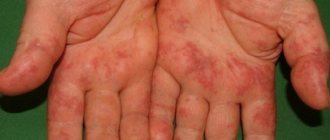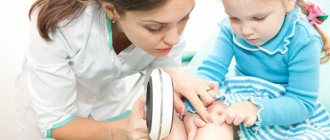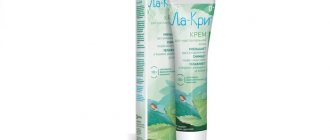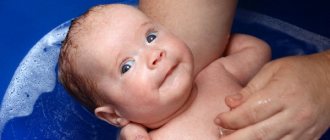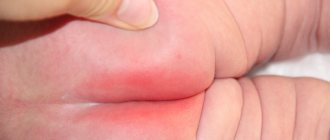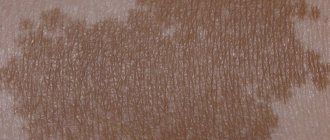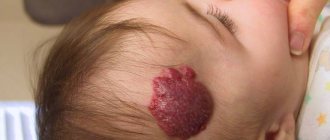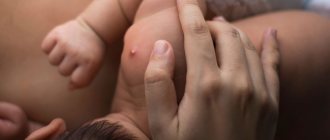In newborn children, many age-related processes occur in the body, some of which have external manifestations that frighten parents. One such process is erythema toxicum of the newborn. It manifests itself as redness of the skin of some parts of the body. This condition is not a disease and is quite normal for a baby. However, this does not mean that you can ignore the manifestations and appearance of your child’s skin. It is necessary to be able to distinguish between different symptoms so as not to miss the development of the real disease.
In this article you will learn how toxic erythema of newborns manifests itself, what are its distinctive signs, as well as measures that will help alleviate the child’s condition and prevent the development of complications.
What is erythema toxicum of the newborn?
toxic erythema of newborns
Toxic erythema is a skin disease that occurs in both newborns and adults.
Toxic erythema (infectious-toxic erythema) is redness of the skin in the form of spots that occurs as a result of intoxication of the body with an allergen. This condition borders on pathology and affects people of any age. It is most often diagnosed in infants in the first days of their life and in this case is called “toxic erythema of the newborn.” In contrast to the relatively normal physiological erythema of newborns, it occurs 4 times less often - in approximately 20% of babies. At the same time, full-term babies who feed on mother's milk are at risk - after all, the allergen that provokes the development of erythema most often enters the body from food. Erythema occurs due to the expansion of skin capillaries, which thus react to the entry of an allergen into the body.
Risk factors that contribute to the aggravation of the pathological reaction are a predisposition to allergies and simultaneous contact with a large amount of allergen.
The immediate causes of toxic erythema can be: autotoxic - allergenic toxins are produced in the body itself due to metabolic disorders; drug - taking medications can trigger the development of toxic erythema. Nutritional – the allergen enters the body with food.
Contact erythema occurs due to direct contact of the allergen with the skin or mucous membranes of the respiratory tract.
The causes of toxic erythema in newborns are most often provoked by something nutritional and arise as a result of the ingestion of a foreign protein into the baby’s digestive tract, which is recognized by the body as an allergen. Therefore, toxic erythema is much less common in formula-fed babies - after all, it is the components of breast milk that can cause an allergic response in the body in some cases.
The following factors significantly increase the risk of developing toxic erythema of newborns: the pregnancy proceeded with complications; during pregnancy, the woman was in obviously unfavorable environmental conditions.
The presence of hormonally caused diseases in the mother or her increased tendency to allergic reactions; intrauterine infection of the fetus; fetal hypoxia; more than 12 hours have passed between the birth of the child and its attachment to the mother’s breast (according to some sources, more than 6 hours).
The first symptoms may appear immediately after contact with the allergen or after a couple of days. In this case, rashes appear on the skin and mucous membranes - they are red and hot to the touch. Itching and burning are not always observed.
Depending on the nature of the rash, the following forms of erythema are distinguished: papular - rashes in the form of nodules or plaques protruding above the surface of the skin; macular - the mildest form of the disease, in which red spots of varying sizes appear on the skin.
Vesicular - rashes in the form of pimples, in place of which crusts then form; nodular - hyperemic nodes with blurred boundaries form on the skin.
Erythema toxicum appears in the first days of a child’s life and its signs are: red spots on the skin that look like insect bites. When touched, a compaction is felt, and in the center of each spot there is a tubercle or bubble. Characteristic localization of spots.
They occur most often on the abdomen, scalp, back, bends of the arms and legs, and never on the palms, soles, and mucous membranes. New spots may appear within a few more days.
Toxic erythema can go away in 2-3 days; it can be accompanied by itching, as a result of which the child becomes restless; with very profuse rashes, the temperature rises and the lymph nodes enlarge; sometimes, over the next 2 weeks, a relapse of the disease occurs.
Treatment of toxic erythema in adults includes: first of all, avoiding contact with the allergen that caused the pathological skin reaction; symptomatic treatment with antihistamines and detoxification drugs: fenistil, cetirizine, loratadine, any diuretics and laxatives to accelerate the removal of toxins from the body.
Severe cases of generalized toxic erythema require hospital treatment. Depending on the characteristics of the course of neonatal toxic erythema of newborns and the degree of necessary intervention, the following forms of the disease are distinguished:
Toxic erythema. Localized – there are few spots, the child’s general condition is normal, medical intervention is not required. Generalized - the rashes are profuse, there are all signs of deterioration in the newborn’s well-being, medication assistance is required.
The standard of care for toxic erythema of newborns are drugs to improve digestion (Biogaia, Bifidumbacterin, Linex), calcium gluconate, vitamins (E, B6, A). If there are vesicles (pimples), they are lubricated with brilliant green or potassium permanganate; in case of peeling of the skin, use zinc ointment, ointment with calendula extract or an oil solution of vitamin E.
General recommendations for the treatment of toxic erythema of newborns, regardless of the abundance of the rash: carefully observe the baby’s hygiene; provide the child with walks in the fresh air and air baths.
Keep plenty of fluids - in addition to breast milk, supplement with water; in case of toxic erythema, the mother is prescribed a strict diet to prevent allergens from getting into breast milk.
Otherwise, when breastfeeding, redness may occur again. You can add potassium permanganate to the bathing water, but not decoctions of various herbs - they can provoke a worsening of the allergic reaction.
The prognosis for toxic erythema in children is favorable. Most often, the rash goes away without a trace within 10-14 days, even without medical intervention. In some cases, a secondary skin infection may occur, but with proper care of the baby this will not happen.
The only thing that is dangerous about toxic erythema is that its appearance indicates a child’s predisposition to the development of atopic dermatitis, so potentially allergenic foods must be introduced into the diet of such a child much more carefully.
Source: idermatolog.net
Why does toxic erythema occur?
“The causes of toxic erythema in infants remain unknown ,” says Olesya Anatolyevna Kluban, neonatologist at the ISIDA clinic. – The most common hypotheses for the occurrence of toxic erythema are as follows :
- activation of the newborn’s immune system in response to stress (childbirth, hypoxia, cooling);
- inflammatory response to skin colonization by normal bacterial flora at birth;
- acute hypergic skin reaction caused by maternal lymphocytes transferred shortly before or during childbirth;
- allergic reaction of the body to external and internal irritants;
- reaction of adaptation mechanisms of newborn skin in relation to mechanical or thermal stimulation.”
Types of erythema
Why does skin redness occur in a newborn?
Indeed, with the development of erythema, active redness of the baby’s skin is observed. This change in skin color can be either local or general. But the very essence of redness of the skin lies in the increase in capillaries. Although erythema of newborns is not considered a disease, appearing exclusively in rare cases and having short-term symptoms, it is necessary and important for caring parents to know about this reaction in order to help the little one cope with this negative sign. So, let's start with the types of erythema in newly born babies. There are two types: physiological and toxic. Let's look at what these types are and how they differ.
Erythema physiological
Physiological erythema is an adaptation of the baby’s skin to the environment. Typically, physiological erythema occurs in newborns from the first days and within one week. During this period, active redness of the skin may be observed throughout the body or only in certain areas. Why does physiological erythema occur?
The essence of this manifestation lies in the impact of external stimuli on the child’s body. Under the influence of negative factors, a sharp flow of blood occurs to the child’s skin, which is called erythema.
The period of illness, or more precisely, the adaptation of the body to the environment, lasts no more than a day. This period is the maximum and is observed in rare cases in newborns. Parents are also worried about whether anything needs to be done about this manifestation in order to save the baby from unnecessary frustration.
It is important to note here that it will not be possible to get rid of the skin disorder on the first day after the appearance of erythema. Parents can only help the child by carrying out the following procedures: Airing the skin, air bath sessions, using special baby creams.
If the child is very difficult to tolerate this disease, then parents do not necessarily have to wait 10 days, but contact the pediatrician immediately. The greatest concern with erythema is itching of the skin, due to which the baby may constantly scream and eat poorly.
To reduce the symptoms of itching, special relaxing baby creams are used. But in addition to the harmless physiological erythema, there is also a toxic one. What it is and why it arises, we will consider further.
Erythema toxicum
Toxic erythema of newborns is already a serious negative manifestation. This type appears even less frequently than the physiological one, but is more dangerous. Toxic erythema occurs against the background of an allergic reaction, which is provoked by the child’s consumption of breast milk. There are children who are allergic to their mother's milk, thereby causing various negative manifestations, including erythema. But there are other reasons for the development of toxic erythema, the appearance of which is difficult to predict. So, the reasons for the development of erythema are as follows: Genetic predisposition or heredity.
A woman's use of various medications in excess quantities during pregnancy. Harmful types of work that a woman worked during pregnancy. If the baby is the firstborn. In frequent cases of insufficient oxygen for the child while in the womb.
Late feeding. If the baby began to be fed no earlier than 10 hours after birth. Some types of diseases in a pregnant woman: diabetes or high blood sugar, impaired functioning of the ovaries and thyroid gland. But there is no need to worry in advance that these reasons universally influence the appearance of erythema toxicum in a child.
This type of disease manifests itself only in rare cases, and the authenticity of the presence of a toxic type can only be verified through symptoms. So, the symptoms that are the main signs that erythema has occurred in newborns are the following: Anxiety and restlessness in the baby.
At the same time, the child is often capricious, sleeps poorly, cries and sometimes even screams. The appearance of red spots on the skin, which spread throughout the body for the first two/three days.
The appearance of bubbles in the central parts of the redness. Itching and scabies on the body. Particularly disturbing is the itching in places of redness, which causes discomfort in the child. As a result of these sensations, the baby becomes more restless. Toxic erythema often appears in the head, arms and legs.
With further exposure to pathogens, redness spreads throughout the body. Thus, it is clear that the most dangerous form of the child’s disease is toxic erythema, which requires certain treatment measures. Treatment includes relieving the unpleasant sensation of itching and alleviating the baby’s condition.
Source: krohapuz.ru
Types of erythema
There are three types of erythema.
Localized
The most common, rarely causes problems, and does not bother the child at all. Groups of large or small spots appear in the chest, buttocks and joints.
Widespread erythema
Causes a little more anxiety. The spots are slightly larger than in the previous case, but do not spread widely throughout the body. The baby may experience mild weakness and fever.
Generalized form
It is considered the most severe, since the spots are much larger and are accompanied by small pustules. The child’s temperature rises more strongly, and irritability due to itching is clearly expressed.
Any of these forms differs only in symptoms, does not carry any consequences or complications, and should end no later than the first week of life, otherwise such erythema is called protracted. The maximum period is 20 days from the date of birth of the child.
If irritation, rashes, and especially the temperature and general lethargic condition of the baby last longer, then a more serious infection with the same symptoms may unnoticed develop next to the natural toxic erythema. Contact a pediatrician and dermatologist, check the general state of the baby’s immunity - for infants there are minimum standards that must be met in order to avoid illness.
Causes
What are the rashes of toxic erythema?
The skin texture becomes uneven due to the pronounced expansion of capillaries in the superficial layer of the dermis. If we consider these reasons, then erythema can be classified as follows: Autotoxic - due to metabolic disorders. Nutritional – the body’s response to food allergies. Medication – adverse reactions to treatment with various types of medications. Contact – damage to the skin develops through direct contact with the allergen, as well as its introduction into the body through the respiratory tract. In newborns, the causes of the disease include: Adaptation to the extrauterine period, the skin tries to adapt to the adverse effects of the external environment. Allergies to the mother's diet - artificially fed children do not have such problems.
Contact with allergens - household dust, washing powder, which is used to wash his things, children's cosmetics and the like. The influence of climatic factors is overheating and hypothermia; overheating is more dangerous for newborns. Infection with unfamiliar microorganisms at the stage until the immune system has stabilized, intrauterine hypoxia.
The following factors can provoke negative skin reactions: Severe maternal toxicosis. The woman had to treat any diseases during pregnancy, and future erythema in the baby is a side effect of taking these drugs. Contact of a pregnant woman with chemicals is also an occupational hazard.
Obesity of a woman and too much weight gain, lack of breastfeeding. Causes of erythema in adults: complications of acute respiratory viral infections and bacterial infections - sinusitis and tonsillitis; osteomyelitis; rheumatism.
Oncological diseases and benign tumors; introduction of protozoa and fungi; chronic diseases in the acute stage. That is, erythema in adults can be provoked by all reasons, the consequence of which is a decrease in immunity.
Source: kozhzdrav.ru
Differential diagnosis
When the first signs of damage appear, you must call the clinic and make an appointment with a specialist. This could be a dermatologist or a practicing pediatrician or allergist. To determine the disease, a general analysis of the blood fluid is prescribed, examining it under a microscope, determining the composition of breast milk, and allergy tests. Differential diagnosis in children is carried out with diathesis, prickly heat, dermatitis, chickenpox, and lichen.
Miliaria in a child
Clinical picture
At birth, the baby's skin is covered with a special lubricant called vernix.
This lubricant is necessary to facilitate passage through the birth canal and, in addition, serves as a reliable protection of the skin from bacteria in the first hours and days of a newborn’s life. Gradually, the lubricant is washed off and erased from the skin, as a result of which 80-85% of babies develop the so-called physiological erythema. This reaction is also called physiological skin catarrh. The second form of skin reaction is erythema toxicum. It is believed that the main reason for this phenomenon is an allergic reaction that occurs to a foreign protein. For example, the protein contained in mother's breast milk. Physiological erythema in newborns can be seen on the skin of the feet. This form of erythema in newborns manifests itself as redness of the skin associated with the expansion of skin capillaries. Most often, redness can be seen on the skin of the hands and feet.
In most cases, physiological erythema appears 2–3 days after the baby is born. The redness lasts for about three days, after which it goes away. A secondary symptom of physiological erythema is peeling of the skin; it appears on the 3rd to 5th day after birth. Clinical manifestations of toxic erythema in newborn infants are observed on the 2nd or 3rd day of the child’s life.
Characteristic symptoms are the appearance of red-gray spots; in addition to spots, small blisters may appear on the skin. Most often, rashes with toxic erythema are localized on the face, head, around the joints, on the chest and buttocks. The allergic reaction that led to the appearance of rashes can be either local or general.
Rashes with toxic erythema in infants disappear without a trace after 2 - 3 days. But sometimes secondary rashes appear within 3 to 4 days. With toxic erythema, the general condition of the baby may be disturbed, the child becomes restless, sometimes there is a slight increase in temperature, an enlarged spleen, and slight hardening of the lymph nodes.
However, in most cases, toxic erythema manifests itself only by the appearance of external rashes, without affecting the physical condition of the baby.
Important! Erythema toxicum is more often observed in newborns who are breastfed. In children receiving artificial milk formula, such an allergic reaction is rare.
Source: dermalatlas.ru
Symptoms and signs of erythema toxicum
The key symptomatic signs of this condition are reddish-gray spots as well as blisters. They are traditionally localized on the baby’s skin, in particular in the back, abdomen, and limbs. The sores make themselves felt on the third day of the baby’s life and persist for no more than three days.
The key feature of the pathology is its ability to resolve on its own without additional intervention. In rare clinical situations, there is a possibility of the formation of compacted lymph nodes, heat and fever, and an enlarged spleen. The child may behave capriciously and restlessly. In 2 weeks the situation may repeat itself, but it will also pass without a trace.
Principles of treatment of toxic erythema of newborns
In most cases, pediatricians do not prescribe specific treatment for its physiological and toxic forms.
The rash goes away on its own, and mommy should not be afraid of its appearance. But sometimes in severe cases, drug treatment is indicated. Therapy begins with air baths. The mother is obliged to protect the child from any negative effects on the skin. If she is breastfeeding, then it is necessary to establish a hypoallergenic diet. All allergens should be removed from the diet of a lactating woman. These are all types of citrus fruits, nuts, chocolate, berries, vegetables and red fruits. The category of allergenic products includes eggs, honey, spices, strong coffee and tea. You can include porridge, boiled or baked lean meat, fresh or stewed vegetables, and fermented milk products in your diet. It is recommended to drink an infusion of chamomile, a decoction of rosehip, which stimulates lactation, and tea with milk (not strong).
If the course of toxic erythema in a child is protracted, then pediatricians prescribe antihistamines. Auxiliary therapy includes products with lacto- and bifidobacterin, vitamins B6, C, E, and rutin. If there is a profuse rash in the navel area, it is recommended to lubricate it with a solution of brilliant green or potassium permanganate.
You can also use zinc oxide powder for this. Sometimes, with a complex course of the toxic type of erythema, newborns are administered a glucose solution or potassium-containing agents. New mothers should know that it is strictly prohibited to independently treat this condition in a newborn.
The treatment regimen should only be drawn up by a pediatrician. To wash children's clothes, you should use special hypoallergenic, phosphate-free products or regular soap. The baby should not be swaddled tightly to avoid increased itching or overheated to prevent diaper rash. You need to bathe your child every evening.
A well-known pediatrician explains the appearance of physiological erythema in children by adaptation to new living conditions. Unlike the mother’s womb, where there was a stable temperature and the skin was constantly in the same stable environment, in the maternity hospital and then at home the child is in more “aggressive” conditions.
And the skin is the first to react to this. Evgeny Komarovsky reminds mom and dad of an unshakable rule: if they see that a rash has appeared on their baby’s face, then the child should be shown to the pediatrician.
After all, the parents themselves cannot accurately determine its nature. And to avoid troubles, it is worth excluding infectious diseases. And only a pediatrician can do this correctly. In addition, with any changes in the condition of the newborn, it will always be useful to be on the safe side.
Dr. Komarovsky states that skin rashes as a manifestation of allergic reactions quite often occur in such children. The appearance of a rash in the maternity hospital should not cause concern to parents, since this is a physiological phenomenon. If it arose at home, after the baby and mother were discharged, then you should be wary.
Perhaps the baby really suffered from the mother’s poor diet or contact with other allergens. And they, according to the doctor, could be pets or even the wrong powder for washing the baby’s bed linen. Also, the rash can be the result of excessive care of the mother, who unnecessarily wraps up the child.
In this case, prickly heat appears on his body. Evgeniy Olegovich strongly recommends performing air baths from the first days of the baby’s appearance in the house, leaving the child naked for a few minutes. He emphasizes the importance of ventilation, wet cleaning and regular exposure of the newborn to fresh air. Then no erythema will threaten the baby.
Source: nashidetki.net
Classification
Cutaneous erythema has two main forms:
- Active (arterial).
- Passive (venous).
Table No. 2. Forms of skin erythema:
|
|
|
Active form of erythema. | The rash is bright pink or red in color | The problem appears due to toxic (medicinal), physical, or infectious effects. |
| Passive form of erythema. | Purple rash | The passive form of erythema occurs in the presence of certain cardiovascular pathologies, for example, acrocyanosis. |
Types of skin erythema
In addition to erythema toxicum, several types of skin changes occur.
Erythema is divided into types, depending on the provoking factor:
- Toxic.
- Viral.
- Allergic.
- Nodal.
- Palmar.
- Multiform.
We will tell you separately what the nature of neonatal toxic erythema is, but now we’ll talk about other types of skin erythema.
Table No. 3. Types of cutaneous erythema:
|
|
| Viral | It is infectious in nature. If the pathology passes in infancy, then the child develops a strong immunity. But when encountered in an adult, the problem becomes severe, accompanied by an increase in body temperature, general weakness, and rashes on the face. |
| Allergic | As medical statistics show, a common cause of allergic erythema is the child’s body’s reaction to breast milk. If a baby has this type of problem, the risk of developing respiratory diseases increases. The doctor does not prescribe treatment in this situation. The exception is a severe form of rash, in which case the child needs to take antihistamines. It is recommended to add a decoction of chamomile, sage, and string to the water when bathing. If the child is breastfed, the mother must remove the suspected allergen from her diet. At the same time, she is prescribed antiallergic drugs and vitamins. |
| Nodal | It can appear at any age, but children under 6 years of age are usually not at risk. In adolescence, this type of erythema can occur as a reaction of the body to streptococcal, staphylococcal infections, as well as to many medications. Girls are most at risk of developing pathology. |
| Palmar | Unlike all types of erythema, this form appears on the baby's palms and soles. The areas of the skin in these places become covered with rashes consisting of small reddish spots located close to each other. The border of the affected areas is clear. As the condition improves, the spots become less pronounced, fade, and during the period of exacerbation, on the contrary, they acquire a bright red color. This form can accompany the child throughout his life. There are frequent cases of palmar erythema in the whole family, the reason for this is the hereditary factor. |
| Multiform | Children aged 5 years and older are affected. Depending on the origin, erythema multiforme is divided into several types: toxic, infectious, allergic. Another type of erythema multiforme is toxic-allergic erythema. Occurs due to intolerance to the drug. |
Pathology also occurs in adults
Erythema toxicum
This type of erythema appears in babies in the first days of their life. Depending on the clinical signs, it is divided into forms:
- Expressed (generalized).
- Not expressed (limited).
The mild form is characterized by a small number of erythematous-popular rashes. At the same time, there is no deterioration in the child’s general well-being. A blood test shows an increase in the number of eosinophilic leukocytes by 5% of normal.
In severe forms, the number of eosinophilic leukocytes is 10% higher than normal. The rashes are multiple.
The following signs may be present:
- anxiety;
- slight increase in body temperature;
- enlarged lymph nodes.
With symptoms of itching and burning of the rash, the child becomes restless.
The duration of toxic erythema depends on the course of the disease:
- with a limited form, the rash disappears on the 5th day;
- in the generalized form, the duration of the rash is up to 20 days.
Boys are more affected by this pathological condition.
Traditional treatment
A visual examination will be sufficient to determine the diagnosis. Sometimes, at the discretion of the doctor, laboratory tests may be prescribed. If the problem does not disappear after some time, and the symptoms only worsen, it is recommended to take mother’s breast milk for allergy tests to identify the allergen.
Drug treatment is generally not required, except in particularly severe cases. Therapy consists of more careful care of the baby’s skin.
The following rules should be followed: Clothing should be chosen from natural fabrics, not tight-fitting, preferably without internal seams, so as not to further irritate delicate skin. Wash baby clothes with products intended for newborns that do not contain synthetic ingredients. Do not use conditioners or fragrances.
It is not recommended to swaddle the baby tightly so as not to impede the flow of oxygen to the skin. Carry out water procedures daily. The water must be boiled and pre-cooled to 36-38 degrees. For some time, it is not advisable to use herbal decoctions while bathing, and use bathing products no more than once a week.
After bathing, easily blot the moisture with a soft towel and never rub the skin. Maintain optimal skin moisture; after bathing, lubricate the skin with baby cream or oil. It will be good to carry out “air baths” for several minutes a day. This will facilitate rapid adaptation and relieve the itching that appears upon contact with clothing.
Avoid overheating, as diaper rash will aggravate the situation and prolong the recovery period. Adhere to the optimal drinking regime for both the child and the mother (if the child is breastfed). Offer additional water to the child, not based on nutritional principles or time of year. Nursing mothers must follow a strict diet.
This is perhaps an important point, since most of the allergens enter the baby’s body through mother’s milk, which is the baby’s main food product. Red foods, nuts, honey, chocolate, eggs and exotic fruits are excluded from the diet. It is also better to completely exclude sweets, since glucose increases allergic reactions.
These recommendations apply to common erythema toxicum. If the problem has become large, additional therapy may be required. For a generalized rash, the specialist prescribes special creams or ointments that are used to treat the lesions. Such procedures will help faster when used together with anti-allergen drugs.
Lactobacterin can be prescribed for internal use; it helps cleanse the intestines and quickly remove toxins from the body. In some cases, a course of taking vitamins C, E and B vitamins is prescribed. To avoid pathological reactions, physiotherapy is prescribed.
When open wounds appear, the skin is treated with hydrogen peroxide and then lubricated with a solution of brilliant green. Basically, erythema does not harm the child’s health, and symptoms usually disappear after a few days.
However, with additional help, the problem will go away much faster. Therefore, after examination by a doctor, you must immediately begin therapy in order to avoid complications that arise if proper care is not followed.
Source: furunkul.com
Tactics for combating toxic erythema
In the lion's share of situations, the disease does not require specialized medical intervention and can go away on its own without taking medications or folk remedies. After 2-3 days, the patient will experience complete relief from the disease and an improvement in overall health. If we talk about the general tactics of getting rid of pathology, we can highlight several general recommendations and principles.
- The child needs to be in contact with the air as often as possible. To do this, instead of tight swaddling, it is necessary to undress him for a short period of time and provide air baths for at least 15 minutes a day.
- It is necessary to provide competent care for the skin rash, in particular around the navel, buttocks, and upper torso. For this purpose, special pharmaceutical and folk remedies sold in pharmacies are used.
- Physiotherapeutic measures will allow you to achieve optimal results instantly. To do this, you need to make an appointment with a doctor, who will prescribe a complex suitable for a particular baby and help carry out complete treatment.
- Monitoring the mother's diet plays an important role. It is necessary to exclude foods that cause allergies in the baby through breast milk. It can be anything; the exact allergen can be determined through special samples and tests.
- Taking antihistamines is only relevant in case of a prolonged allergic reaction. If the rash begins to go away on its own, there is no need to take medication.
- Vitamin therapy also helps strengthen the immune system and the body’s fight against rashes; attention should be paid to vitamin components B6, C, E.
Thus, no specific therapeutic intervention is required. It is necessary to follow general measures and follow the recommendations of doctors.
Folk remedies
There are no special recommendations for caring for a child who has physiological erythema, since the spots do not cause pain or itching.
Experts advise taking care of your skin with regular cosmetics intended for newborns. In order not to aggravate the problem, avoid overheating the body - in the room where the child sleeps, the temperature should fluctuate between 20-22 ° C. In addition, take daily baths in water with a temperature no higher than 37 ° C. To make the symptoms disappear faster, we suggest you use proven folk remedies.
Starch
You can treat with starch baths. This product soothes irritated skin and covers it with a protective film. So, take water at a temperature of 36-37 C into a small baby bath and add a glass of starch there.
Potato or corn starch will work, but the latter option is preferable since corn starch contains more nutrients. Bathe your baby, then gently dry him with a diaper and dress him in soft clothes. Carry out the procedure daily until all symptoms go away.
Lovage
For children diagnosed with erythema toxicum, baths with a decoction of lovage root will be useful. This plant has long been used in bathing babies. It helped prevent all skin diseases and remove the symptoms of existing problems. Boil a handful of chopped lovage roots or leaves in 2 liters of water, cool.
Strain and pour into your bathtub. Let the baby take the procedure for 15 minutes, then wrap him in a towel and put him to rest. Repeat treatment daily.
Series
Erythema in newborns will quickly disappear if you use the power of the series. This plant dries out the rash and disinfects the skin. Pour a glass of string grass with a liter of water, bring to a boil, cover and leave for 5 minutes.
Then strain and pour into the water of the day of bathing, but leave a little of the infusion. Give your child a bath every day. Apply the remaining infusion to the stains several times a day to help the symptoms go away faster.
Flax-seed
Treatment with flaxseed will also be of great benefit to sick children if they have toxic erythema. At night, pour 2 tablespoons of the seed into a glass, add 100 ml of warm (but not hot) water and cover with a lid.
In the morning, drink the infusion. You should have a viscous liquid. Add a few drops of tea tree oil to it. Wipe your baby's skin with this product several times a day.
Whey is the liquid that remains after making cottage cheese. It has a whole range of substances that are beneficial for the skin. Therefore, if your baby has erythema of the newborn, treat with this remedy.
Heat the serum to a temperature of 40 C, moisten a piece of sterile cotton wool with it and treat the baby’s skin. Wait 20 minutes, then wash off the serum with a cotton swab dipped in clean boiled water. Repeat this manipulation several times a day.
Sea buckthorn oil
Everyone knows that sea buckthorn oil heals the skin. In addition, it is harmless even for infants. Lubricate the affected areas with it 2 times a day, morning and evening, so that the spots disappear faster.
Perhaps the most famous medicinal plant is chamomile. Its flowers will also help if your little one has erythema of the newborn. Make a decoction of any concentration from chamomile, strain and add to the bath for bathing. By the way, you can give your baby 1 teaspoon of chamomile tea orally to keep the child’s body strong and healthy.
Arnica ointment
Stores and pharmacies sell special ointments for small children, but they are expensive. Why pay extra money if you can make the ointment yourself.
We suggest using arnica for this purpose. The root of this plant must be ground in a mortar to a powder, and then combined with unsalted pork fat (2 cups of fat per 100 g of powder).
Place all this in a water bath and cook for 2 hours (or you can simmer in the oven for 2 hours). Apply the resulting ointment to the areas where there are stains. Continue treatment until complete recovery.
Source: nmed.org
Symptoms in newborns
Erythema toxicum appears in the first days of a child’s life and its signs are:
- red spots on the skin, similar in appearance to insect bites: when palpated, a thickening is felt, and in the center of each spot there is a bump or vesicle
- characteristic localization of spots: on the abdomen, scalp, back, bends of the arms and legs, most often appear on the palms, soles, mucous membranes
- new spots may appear within a few more days. Toxic erythema can go away in 2-3 days
- may be accompanied by itching, causing the child to become restless
- with very severe rashes, the temperature rises and the lymph nodes become enlarged
- sometimes the disease relapses within the next 2 weeks
Top
Diagnostics
Toxic erythema is a mild disease that does not have consequences for the body. Even without treatment, all symptoms will go away in no more than a week.
But it’s worth contacting a specialist, especially when it comes to infants. The diagnosis is made by an allergist, dermatologist or pediatrician.
The standard diagnostic procedure includes the following steps:
- visual inspection;
- donating blood for analysis;
- checking mother's milk;
- allergy tests;
- examination of the top layer of skin under a microscope.
It is necessary to seek help from a pediatrician, even if parents are confident in the diagnosis. This must be done to exclude pathologies.
Physiological erythema
Having been born, the baby finds himself in a new environment, and adaptation processes immediately begin in his body. Their consequence may be the occurrence of erythema.
Causes of physiological erythema
The skin of a newborn differs from the skin of an adult: it is very delicate, easily vulnerable, thin, so it is often from the skin that responses to irritants appear.
In addition to the structural features of the skin, the causes of physiological erythema are:
- imperfection of thermoregulation processes in the body;
- irritating effects of ambient temperature and humidity;
- erasing the original lubricant. It remains on the baby's body in the first days after birth. Lubrication is necessary for the baby: in the womb it protects it from infection from amniotic fluid, during childbirth from injuries, and afterwards from the aggressive influence of unusual environmental factors for the child.
Symptoms of physiological erythema
Signs of physiological erythema are:
- redness of the skin either in individual areas (mainly on the arms and legs) or throughout the body. This occurs as a result of capillary expansion due to strong blood flow to the skin during adaptation;
- This condition usually occurs 2-3 days after birth and goes away without a trace after 7-10 days as the child’s body gets used to environmental factors.
What to do
As a rule, the appearance of physiological erythema does not require special measures on the part of parents. The condition goes away on its own without consequences. The main thing is to follow the rules of caring for a newborn’s skin:
- change diapers on time;
- use clothes made from natural fabrics;
- Regular air baths will also be useful;
- after bathing, do not dry the child’s skin with a towel, but pat it dry;
- In some cases, erythema may cause peeling of the skin, then you should use baby cream after consulting with your pediatrician.
Young parents need to know that this type of erythema in children occurs frequently - in 65% of cases, and there is no need to be afraid of it.
